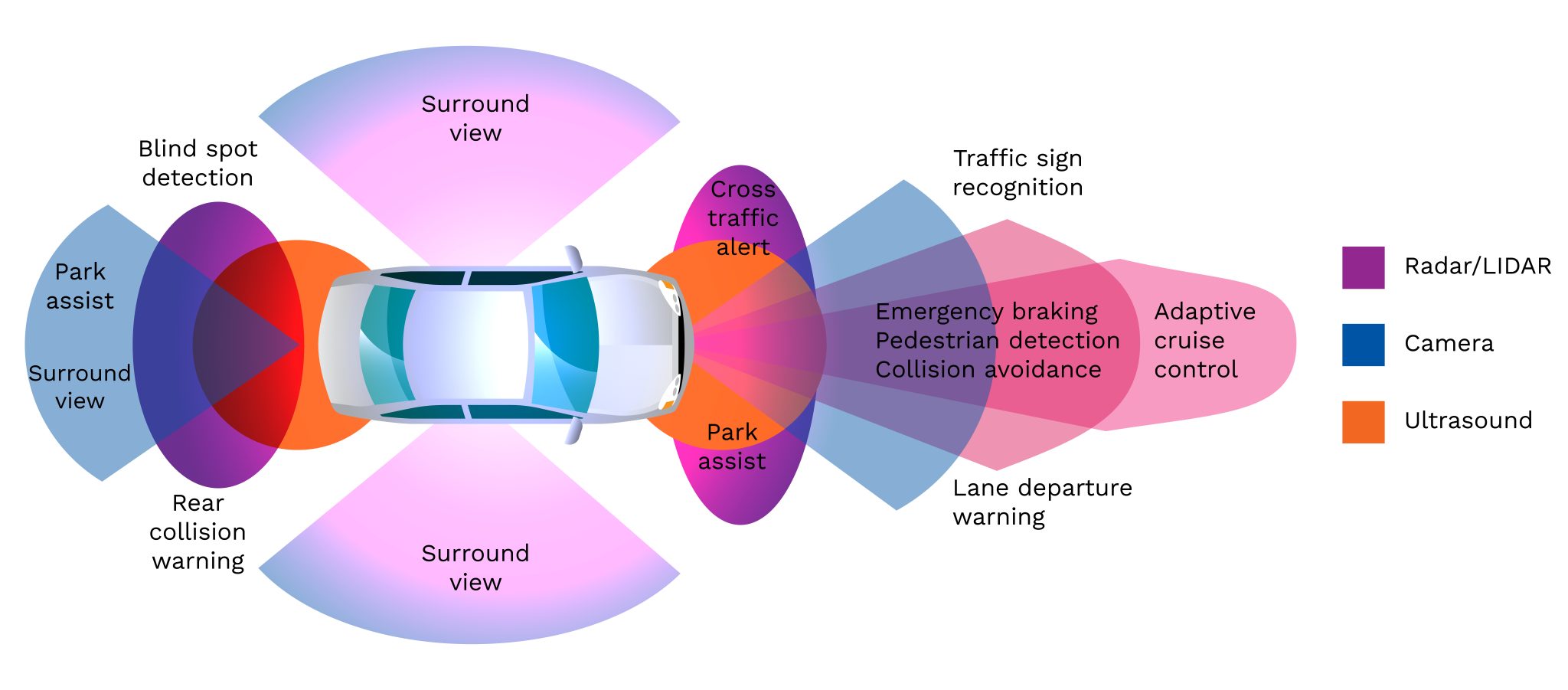Introduction
Complex systems known as Advanced Driver-Assistance Systems (ADAS) carry out various computer vision functions, that include semantic segmentation, object identification, and picture classification. A report published in Markets and Markets states that the ADAS market size was evaluated at USD 30.9 billion in 2022 and is anticipated to achieve USD 65.1 billion by 2023 at a CAGR of 9.7% during the prediction period of 2022-2030.
ADAS are intended to enhance vehicle safety. With enhanced signals and automated procedures, these technologies improve safety and response times to possible risks.
While some of these systems can be installed later to allow the driver to personalize the car, some vehicles have aftermarket features and even full systems as standard.
What is ADAS (Advanced Driver-Assistance Systems)?
ADAS, or advanced driver assistance systems, are digital technologies that assist drivers with basic parking and navigation without totally automating the process. Instead, they employ computer networks to make driving more secure and data driven.
When correctly developed, these devices employ a human-machine interface to enhance the driver’s capacity to respond to potential traffic risks. These gadgets use automated and early warning systems to increase safety and response times to potential dangers.
A human mistake is the primary cause of almost all car crashes. Modern driving assistance technologies (ADAS) can help prevent this.
Why is Advance Driver-Assistance Systems important?
The primary reason for traffic wrecks is the consequence of human fault. The state-of-the-art safety technology systems automate and enhance many parts related to driving, to better safety and secure driving operations.
ADAS has been found to minimize the amount of road deaths by lowering the likelihood of human error.
These gadgets are classified into two types: 1) those that improve driver awareness, such as lane departure warning systems, and 2) those that automate driving, such as automatic emergency braking systems.
The primary objective of these safety technologies is to reduce vehicle injuries and traffic accident frequency to make roadways safer generally.
They also limit the number of insurance claims that arise from little accidents that simply result in property damage and no injuries.
Advantages of ADAS
Advanced driver assistance systems (ADAS) are passive and active safety equipment that eliminate human mistakes while driving various types of vehicles. Let’s have a look at the advantages-
- Automates the improvement of safety systems– Safety programs that are automatically adopted and upgraded benefit driving populations. ADAS aims to reduce collisions by alerting drivers to potential hazards and taking control of the vehicle to avert them.
- Actions with adaptable attributes- Navigation systems that alert drivers of potential risks such as automobiles in blind spots, lane departures, and others include automated lighting, pedestrian collision avoidance mitigation (PCAM), and adaptive cruise control.
- Aids in the perception of traffic situations- The driver is in the middle of the cycle of traffic-driver-vehicle. The driver perception system gets input from the traffic conditions, which leads it to act as a stimulation of the driver’s purpose. Knowing the current traffic situation will help the intention inference system.
- Analyze and comprehend driving behavior- The most important signs before making a lane shift are driver activities such as checking mirrors. Before changing lanes, drivers must do several checks to ensure they are fully aware of the situation. As a result, analyzing driving behavior is crucial for understanding the driver’s intent. To predict driver lane-change intention, one must first understand the process of human intent, including how it occurs and the elements that influence it.
- Predictive upkeep choices– Predictive technology analyzes threats and delivers data over the cloud to notify consumers of any car problems by combining cloud computing, edge computing, data collection from sensors, and analytics. Fuel level, tire pressure, engine state, navigation route, speed, temperature, and other metrics are monitored in-vehicle to warn the user of any maintenance concerns and to ensure safety.
How does ADAS work?
The upcoming generation of mobile-connected gadgets is built on automobiles, and autonomous vehicle technology is advancing quickly. Systems on a chip, also known as autonomous application solutions, comprise several chips. (SoCs). These chips use high-performance electronic controller units (ECUs) and interfaces to link sensors and actuators.
Self-driving cars obtain 360-degree vision, both close (inside the vehicle’s immediate neighborhood) and far using a range of different applications and technology. This means that hardware designs are becoming more advanced to reach ever-higher performance targets while also decreasing power and footprint constraints.
eInfochips has worked with a client to help them in the porting and optimization of ADAS algorithms on Hydra DSP.

Types of Assistance Driver Assistance Systems
There are two kinds of advanced driver-assistance systems:
- Passive Assistance Driver Assistance Systems (ADAS)- Regardless of the number or type of sensors employed in a passive ADAS system, the computer alerts the driver to a potentially hazardous situation. To avoid an accident induced by this condition, the driver must proceed with caution. Standard warning systems include sirens, flashing lights, and, in some circumstances, sensory input, such as a steering wheel that vibrates to notify the driver that the zone they are entering has previously been occupied by another vehicle (blind spot detection).
- Active Assistance Driver Assistance Systems- In these ADAS systems, the automobile makes active actions. The car can act on its own to avert worst-case circumstances. When an approaching collision is detected, automatic emergency braking (AEB) deploys the brakes without the driver’s input. Adaptive cruise control (ACC), lane-keeping assist (LKA), lane centering (LC), and traffic jam assist are all functional features.
Main Sensors used in ADAS
ADAS employ many sensors to increase vehicle safety and provide a wide range of automated driving capabilities.
In ADAS, four types of sensors are commonly used:
- Camera Sensors: Camera-based solutions have emerged as the most preferred sensor technology among ADAS developers. Though the technology is still in its early stages when compared to radar or ultrasonic sensors, it is efficient and versatile. Their shortcomings include vulnerability to poor performance in bad weather and low or troublesome light conditions. Cameras are the only sensors in this class that can discriminate between color and contrast, thus they are the ideal choice for capturing traffic signs and markings.
- Radar Sensors: Radar sensors are also widely utilized in ADAS systems, most typically as part of a collision-avoidance system. This type of ADAS sensor produces radio waves, which reflect on objects before coming to the sensor. The distance between an object and the wave is determined by the time it takes to return. A computer utilizes this information to assess the surrounding area and create a three-dimensional image.
- Lidar Sensors: Light Detection and Ranging (Lidar) systems, like radar, use lasers to detect distances. Lidar sensors can also find small items precisely and effectively. They can detect people and geographical irregularities, for example. Lidar uses billions of light photons every second to identify non-stationary objects. It detects nearby objects using a pulsed laser.
- Ultrasonic/Sonar Sensors: The primary uses of ultrasonic sensors are parking assistance and self-parking systems. These ADAS sensors are located on the front and/or rear bumper covers, and use reflected high-frequency sound waves to distinguish humans, other cars, and other adjacent objects. Sonar sensors may also identify if a car is properly parked based on how it is positioned in the region. If this function determines that the vehicle has gone outside of an approved zone, it will either sound a warning tone or use brake control to reposition the vehicle to a more appropriate area.
- Human-Machine Interface (HMI): The Human-Machine Interface (HMI) in Advanced Driver Assistance Systems (ADAS) greatly improves the driver’s connection with the vehicle’s automated systems. ADAS refers to a group of technologies and systems designed to help improve the driving experience by offering convenience and safety features.
Advanced Driver Assistance System (ADAS) Application
To know about the technologies that enhance vehicle safety, check out this insightful blog on- Top 7 ADAS Technologies that Improve Vehicle Safety. Some of the most frequent ADAS applications include:
Adaptive Cruise Control
On the highway, where drivers typically struggle to retain track of their speed and other cars for long periods, adaptive cruise control is especially vital. Advanced cruise control lets automatically accelerate, decelerate, and even stop the vehicle based on the actions of other nearby objects.
Glare-Free High Beam and Pixel Light
The glare-free high-beam and pixel lights use sensors to detect the vehicle’s vicinity and darkness while averting incoming traffic. The clever headlight software detects other vehicles’ lights and redirects them away from other road users, preventing them from becoming temporarily blinded.
Blind Spot Detection
This system informs you quickly if a car is in your blind area, allowing you to change lanes safely. With blind spot detection, you can be certain that you are aware of any surrounding cars, allowing you to make safe and educated driving decisions.
Automatic Parking
It’s scary to park your car in a tight spot after maneuvering it several times. That’s where Automatic Parking technology comes in, taking the stress out of parking by automatically directing your car into a slot, whether parallel parking or navigating a limited parking space.
Navigation System
When driving in a new city without a local guide, the Navigation System works as a personal guide. Modern Navigation Systems make folding maps obsolete while making it easier to reach your destination, whether you’re touring a new city or enjoying a road trip.
Driver Monitoring System
This technology uses cameras and sensors to keep you vigilant and centered on the road. It also analyzes your driving habits and notifies you if it detects symptoms of sleepiness or attention. With this function, you can be certain that you are constantly attentive, aware, and driving in the finest conditions imaginable.
Night Vision
This innovative technology lights the road in difficult low-light circumstances. You may maneuver with ease and comfort even in the dead of night if your automobile is equipped with night vision. The powerful imaging technology identifies and displays items on your vehicle’s display, keeping you aware of your surroundings.
5G and V2X
These technologies improve your vehicle’s connection, allowing it to talk with other cars and road infrastructure. You can have a safer driving experience with 5G and V2X, which provide real-time traffic updates for better route choices and help you avoid accidents and congestion.
To learn more about our key service offerings in ADAS and autonomous vehicles, click here.
Difference between ADAS and Autonomous Driving
ADAS and autonomous driving are two separate technologies. While ADAS is a collection of technologies aimed at enhancing overall driving safety, autonomous driving refers to vehicles that are clever enough to drive themselves without human involvement.
While vehicles with the most advanced ADAS technology, such as the MG Astor, are becoming more nuanced and intelligent, the driver must still maintain control of the car. Autonomous vehicles, such as the Tesla Model S, can operate independently with little or no driver assistance.
Conclusion
It is critical to emphasize that ADAS does not replace drivers; they continue to focus on the road and follow every traffic rule. The use of ADAS technology has the potential to increase worldwide road safety. ADAS is becoming almost ubiquitous. From high-end models to tiny budget automobiles, they provide a wide range of features centered on driver safety. With all the expanded amenities and enjoyment material accessible in a car, the driver must still focus on driving. To know more about our offerings in ADAS contact our team of experts today.












